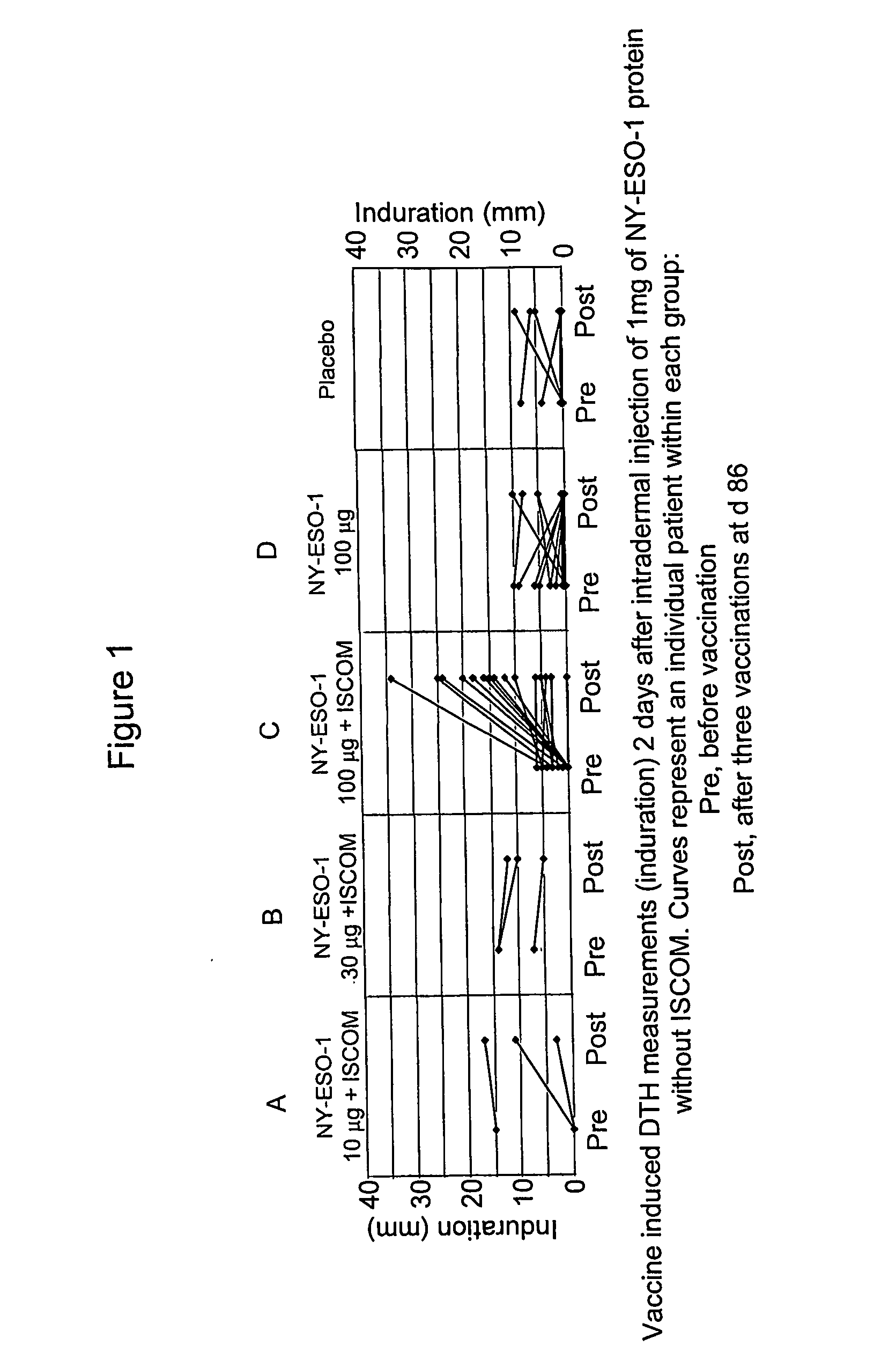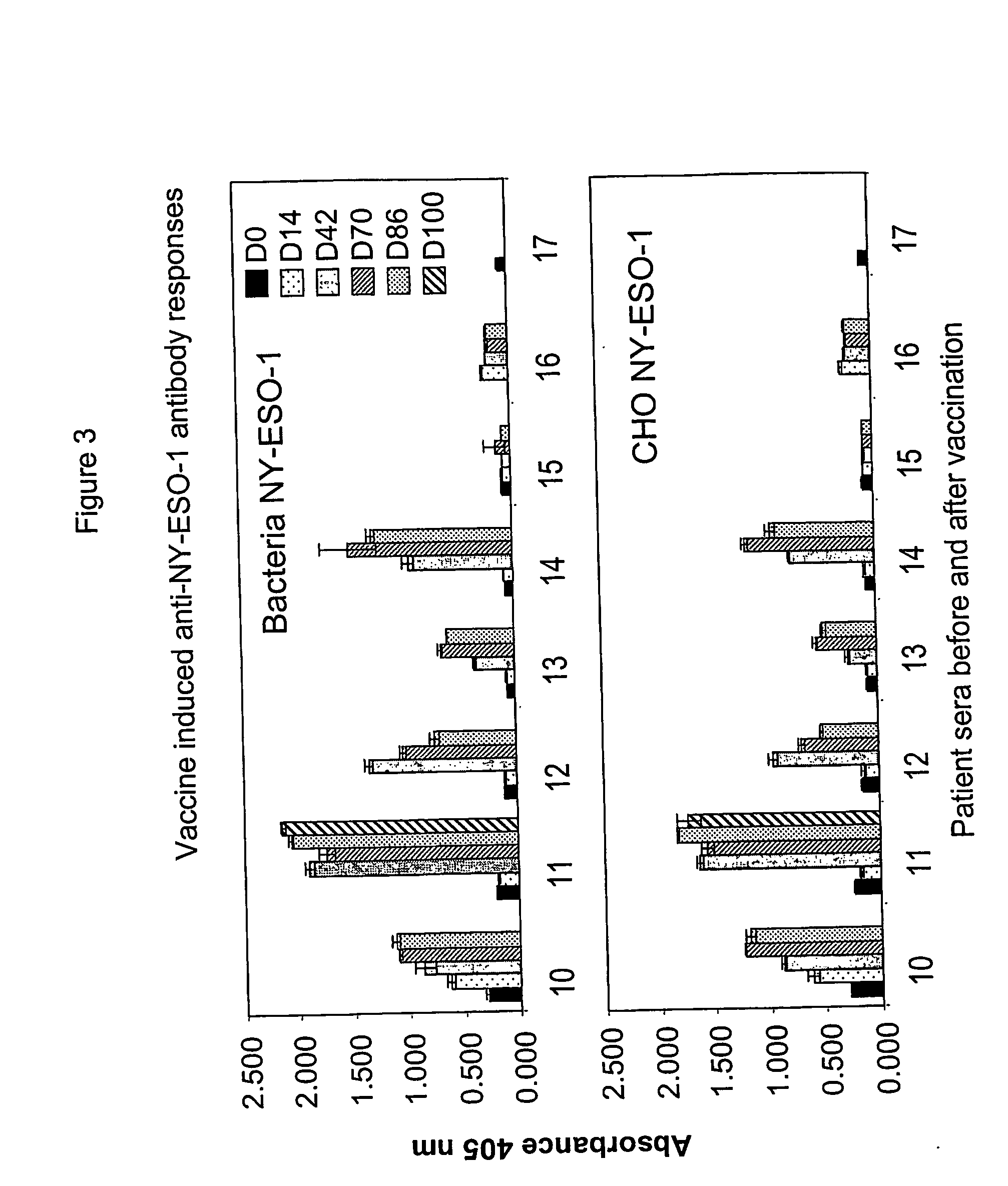In vivo efficacy of ny-eso-1 plus adjuvant
a technology of nyeso-1 and adjuvant, which is applied in the field of in vivo efficacy of nyeso-1 plus adjuvant, can solve the problems of disappointing than encouraging clinical outcomes, and not enough emphasis on the t cell interaction between cd8sup>+/sup> and cd4sup>+/sup>
- Summary
- Abstract
- Description
- Claims
- Application Information
AI Technical Summary
Problems solved by technology
Method used
Image
Examples
example 1
[0021] This example describes the in vivo study used to test the formulation described supra. In brief, it was a double blind, placebo controlled, phase I dose escalation clinical trial.
[0022] Eligible patients were defined as those who had previously exhibited a cancer that expressed NY-ESO-1, as determined either by immunohistochemistry, or RT-PCR. Patients had minimal residual disease (i.e., no detectable disease, or small volume, locoregional disease only), and a relapse risk of at least 25% within 5 years). Further, patients had to have no other effective therapy available, or appropriate, an expected survival time of at least 3 months, and had to have received no immunodeficiency or immunosuppressive therapy.
[0023] Five dose levels were used: dose level A was 10 μg of NY-ESO-1 protein in 121 μg ISCOM (3 patients); dose level B was 36 μg of the protein in 36 μg ISCOM (3 patients); dose level C was 100 μg of protein in 120 μg ISCOM (16 patients, divided equally between HLA-A2 ...
example 2
[0025] Patients were examined for DTH reactions, at the baseline of the study, and at the 84th day. Two days after the injection of the 1 μg of NY-ESO-1 protein (i.e., at days 2 and 86), induration and erythema were measured. These measurements were taken before and after the vaccinations. Pre-existing reactivity was defined as a baseline induration of at least 6 mm. A positive response to vaccination was defined as one where the second reading was at least 6 mm, and at least double the baseline.
[0026] Patients who received vaccines commonly developed DTH responses, especially when receiving dose level C. Some significant DTH responses were observed. These responses were characterized by erythema and induration. Biopsies of the reactions showed dermal, lymphoid infiltrates, consisting primarily of CD4+ T cells, and a lesser population of CD8+ T cells. The specificity of the CD8+ and CD4+ T cells infiltrate was assessed in one of these DTH positive patients. Isolated infiltrating ly...
example 3
[0029] Subjects were also tested to determine if they had developed antibody responses to NY-ESO-1. The assays were carried out in a standard ELISA, as taught by Stockert, et al., J. Exp. Med., 187:1349 (1998). In brief, the capture antigen was the same, purified, NY-ESO-1 protein used in the manufacture of the vaccine. The detection antibody was horseradish peroxidase labeled, affinity purified, goat anti-human IgG. The assay was carried out at 5 points in time, i.e., before vaccination and then at days 14, 42, 70 and 86.
[0030] Patients who had a pretreatment titer greater than 5000 were deemed to have a pre-existing response, while patients with a pretreatment titer below 5000, who developed a titer above 5000 at any point following vaccination humoral, were deemed to have a positive antibody response to NY-ESO-1.
[0031] In all, three of the patients had a pre-existing antibody titer above 5000, which did not change significantly during the vaccination protocol. All patients who ...
PUM
| Property | Measurement | Unit |
|---|---|---|
| Mass | aaaaa | aaaaa |
| Mass | aaaaa | aaaaa |
| Composition | aaaaa | aaaaa |
Abstract
Description
Claims
Application Information
 Login to View More
Login to View More - R&D
- Intellectual Property
- Life Sciences
- Materials
- Tech Scout
- Unparalleled Data Quality
- Higher Quality Content
- 60% Fewer Hallucinations
Browse by: Latest US Patents, China's latest patents, Technical Efficacy Thesaurus, Application Domain, Technology Topic, Popular Technical Reports.
© 2025 PatSnap. All rights reserved.Legal|Privacy policy|Modern Slavery Act Transparency Statement|Sitemap|About US| Contact US: help@patsnap.com



